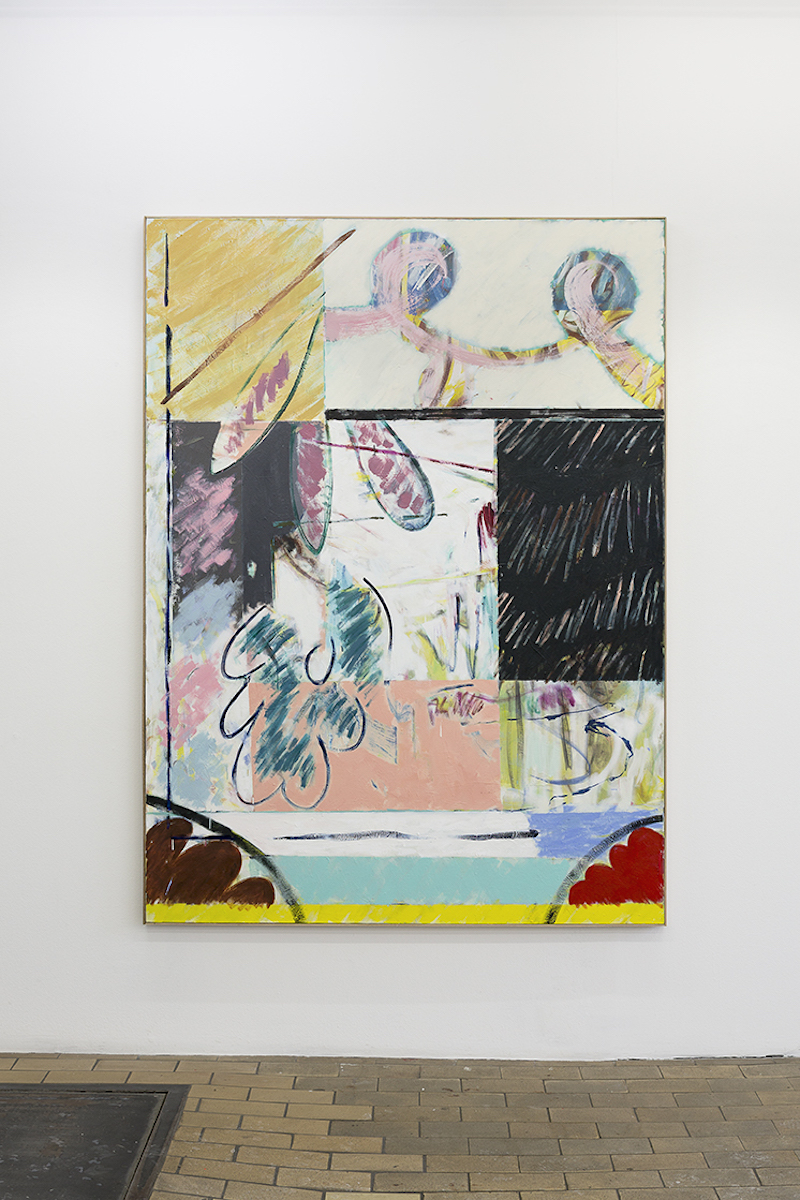
all works © Jon Pilkington at V1 Gallery Copenhagen, 2016
There is a playfulness attached to the surface of the colourful paintings by 26-year old British artist Jon Pilkington: circles, drops, stains, leafy and ornamental forms cover both small and large works. They deceive the eyes for a moment, preventing the sight to realise that the game is in fact a quite ritualistic, almost manic experiment of repeatedly producing similar motifs into a new surface on a canvas with the basic tools of painting: colour, form, composition. Chance and failure play a large role in this process. Jon, who works in a small studio space in London's busy art district Peckham, currently has his works on display in a group show at Rod Barton gallery, around the corner of his studio, and in the solo show 'Two Loops' at V1 Gallery, which is based in Copenhagen's meat-packing-district. We talked about what he does and what he doesn't consider essential in paintings.
Anna-Lena Werner: Jon, you graduated in 2013 at Chelsea College of Art and Design. By that time you were only 22 years old. When did you initially decide to become an artist and what influenced your decision?
Jon Pilkington: I was at college doing history a levels and it was really bad, I hated it. I had always drawn and painted, but not seriously until i dropped out of college after one year of a levels and took a foundation course one year early, when I was 17 – you are supposed to be 18. The tutor of painting was really great and I think that subconsciously pushed me on into painting. We never looked back.
ALW: Do you remember what he said to you, to convince you to become a painter?
JP: He was quite formal, had a good understanding of colour and palette, and how to paint. I think that was quite contagious. I still think of that when i mix colours. There was also a big emphasis on playing, trying and failing. Something that still happens
ALW: Trial and error. Like in Joseph Albers’ painting experiments…
JP: …Yes, I think the not knowing sometimes is really great, but at points its super frustrating. The starting of a painting is always more difficult.
ALW: You just mentioned the mixing of colours. Your paintings are extremely colourful. Do you have a certain routine or process how to choose colour for a composition?
JP: The colours are very conscious, very synthetic, paired with these organic forms. Often compositions find themselves, obviously there are motifs that are repeated time and time again. They are becoming larger, more focused, really contrived and the colour becomes more intense.
ALW: Some of your newer works have become more pale than older ones, which typically have strong colours. Are you beginning to work on a new sort of palette of tones?
JP: Yes, the colours are becoming closer in tone rather than so excessive. I am more interested in the work almost sitting back rather than being so forceful. The recent paintings are also of the moment, I go through phases and different works reflect this. Now that the current works are on show and out of the studio it feels necessary to go against what I did before. Pastel tones are very recurrent in both shows and this plays a part in the works, but in varying degrees. At times it is about toning it down.
ALW: Toning it down, however, doesn't equal reduction in your compositions, does it?
JP: No, it almost allows the composition to be more free or less contained. This is evident in the surface of the works. The larger works are heavily worked and laboured over, whereas the smaller paintings are much more direct and often have this really synthetic quality to them.
ALW: You once said that most of the motifs and shapes that you paint are eventually mere excuses to apply paint on canvas. If the motif thus has no specific value, what is essential to you in a painting?
JP: The motif is always important, not that it is a specific motif more the fact that it recurs. It translates from one canvas to another, it may be fragmented or enhanced and becomes less real each time I paint it. It almost has a comical connotation because of this. As for the essentials in a painting: Form is the most important. compositionally, the fragments within each work that separate decisions and cover the history. Surface is very important, i started to mix paint directly from the floor in the studio which incorporates this real gritty value into the sweetness of the palette
ALW: Is there a sense of ritualism involved in the frequent repetition of shapes and forms in your practice?
JP: Yes definitely, its quite like a performance, quite rhythmic. The action of painting is almost like dancing, stepping over wet paint moving from one canvas to the next, working on lots of works at one time also means that there is no distance from the work. So things recur, even the things that shouldn’t.
ALW: What kind of things would that be?
JP: It’s often things that you are trying to get away from. I’m conscious of paintings all looking too similar, but thats kind of the point. It’s when they are too close that it bothers me. Paintings should be sisters not twins… like eyebrows.
ALW: One recurring motif in your works is the leaf and leafy shapes. When and why did you begin to incorporate that form?
JP: The leaf is a very organic form, it started as a loose hand movement that then started to become more and more conscious. Like when we made the ‘Form is what happens’ show, every work contained the ‘leaf’ motif which we discussed and played with. Often the motifs aren’t actually legible or meant to be anything specifically. It’s more about being open to begin with and people start to put connotations on the motifs. It is at that point that the repetition and contrived sensibility in the work really thrives.
ALW: Have you noticed that you created quite a contrast between the leaf as organic and the colours of smaller paintings as synthetic.
JP: Yes, its about marrying these organic forms that often come from accidents and playing with how synthetic it can possibly become.
ALW: That’s a nice way to put it! How much of a painting is in fact planned beforehand, and how much happens as you go?
JP: It’s a bit of both. The paintings all come from very loose figurative drawings, like ornaments, leaves, scribbles, door knobs and so on. They sit on the studio floor all overlapping each other all covered in paint, drips from paintings foot marks, food. I loosely take sections or crops from these drawings in accordance to how they sit on top of each other or how they work with the drawings next to it. This makes up the divides and the fragments in the work. Compositions aren’t planned it all depends on which way the drawings fall. I like that chance element: it kind of leaves a little bit of room to move, its not rigid. This explains the layering process. With the smaller works I know a lot more of how it is going to look, as I often take grabs or sections and over-amplify them.
ALW: A compositional pattern that you have been using in almost all of your paintings is the fragments, that you mentioned before. Most typically you use the horizontal line in the bottom or the middle of the painting, separating one colour or pattern from another one. Other works are separated into two diagonal fields, or four squares or they are framed by four simple lines. How much do collage techniques play a role in this separation of fragments, blocks and spaces?
JP: Collage plays a big part, but they aren’t collage paintings. They are all so close, it may be one group of drawings that have influenced a series of works. It goes back to working on so many things at once. I have a particular draw to the horizontal line, it has become a motif in itself. The colours are often so jarring that those sharp lines – that actually aren’t so sharp or straight – act as a counter balance to reel it back in. The works are very self aware, the horizontal line in particular plays on that theory of over emphasising the motif until it no longer means anything or just becomes pattern making
ALW: What about titles? Do they mean anything?
JP: The titles are all personal in jokes, or of a time that often hark back to something or someone. It’s often things that make me laugh. It’s hard to separate these things from painting, so I don’t.
ALW: Which title is your favourite?
JP: Two loops, of course.
Current Exhibitions
Jon Pilkington
Two Loops
15.01 - 20.02.2016
Flæsketorvet 69 - 71
1711 Copenhagen V
Denmark
Opening hours: Wed - Fri: 12:00 - 18:00; Sat: 12:00 - 16:00
Jon Pilkington, Ryan Nord Kitchen, Stefanie Heinze
15.01- 20.02.2016
41-43 Consort Road,
LONDON, SE15 3SS
England
Opening hours: Thursday - Saturday 12:00 - 18:00



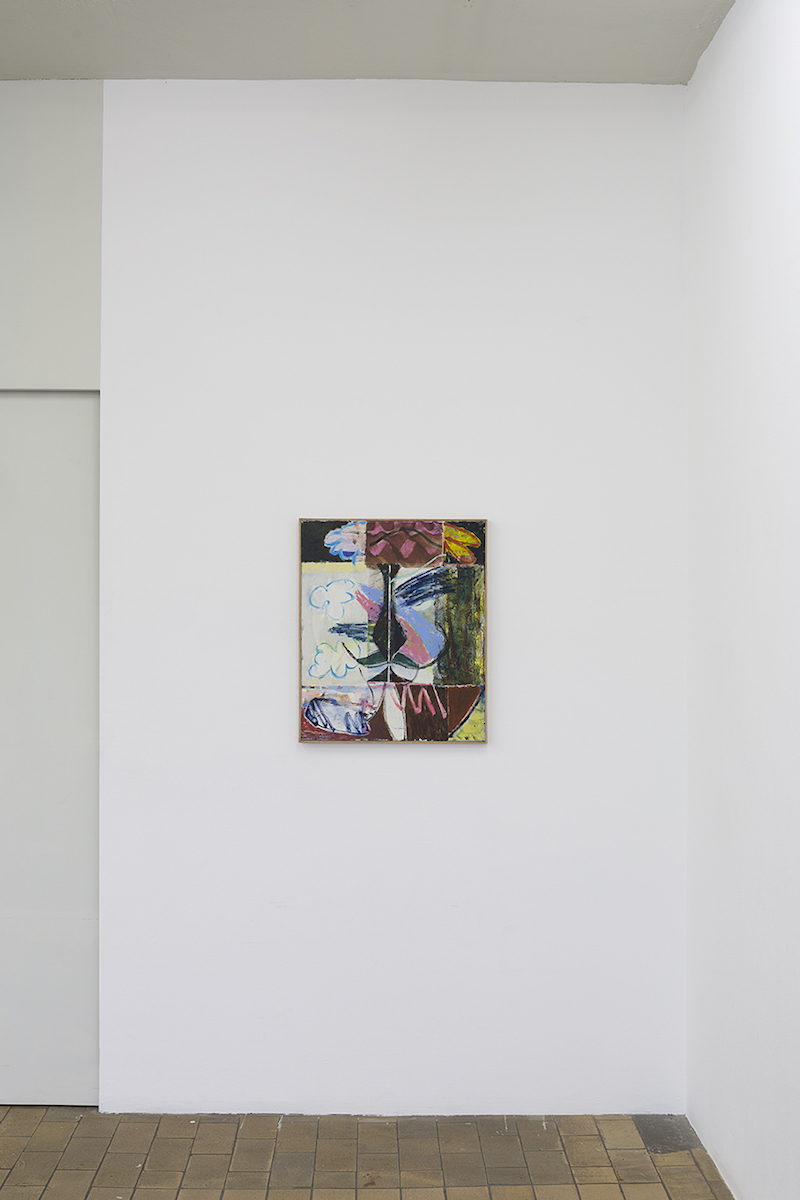




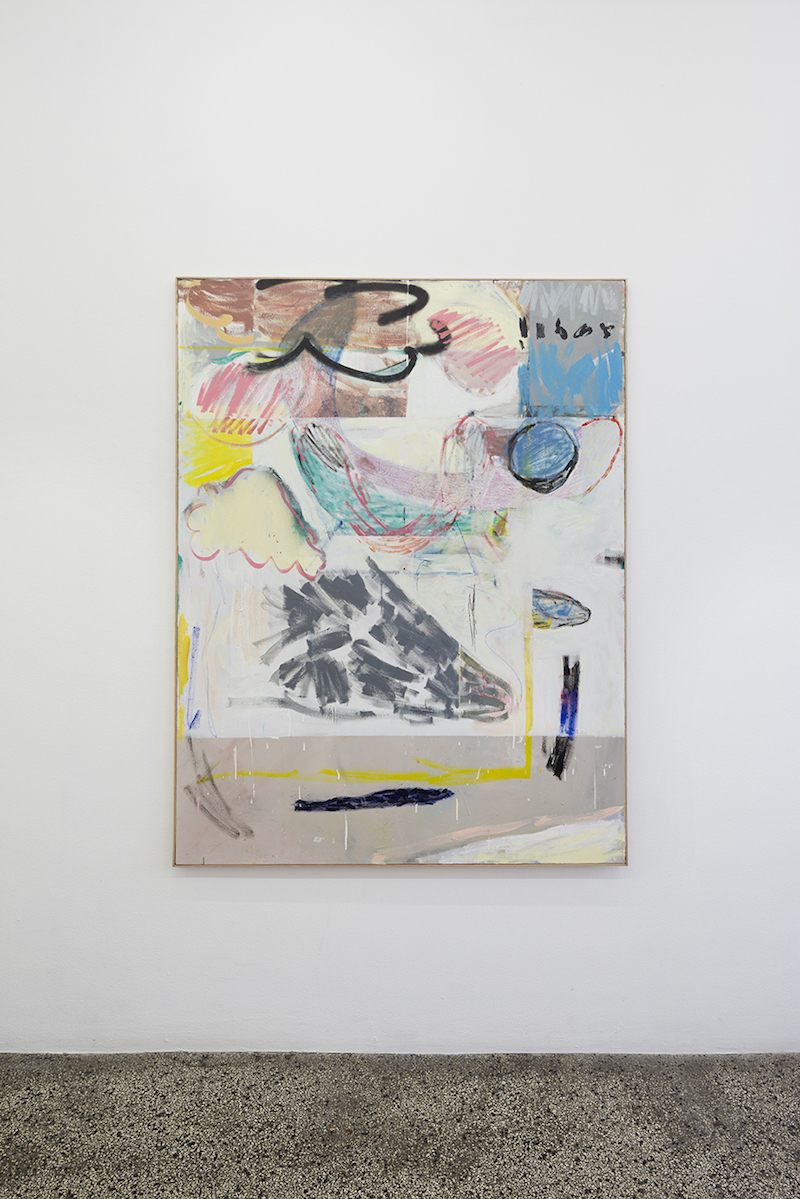
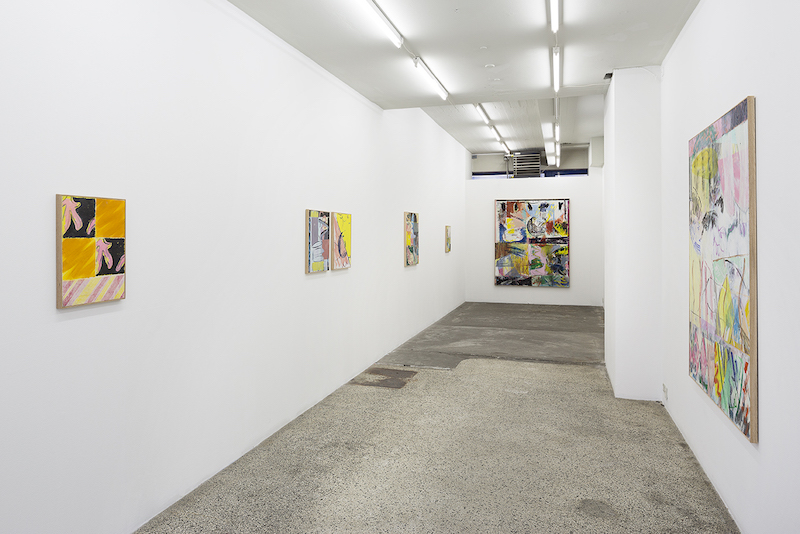

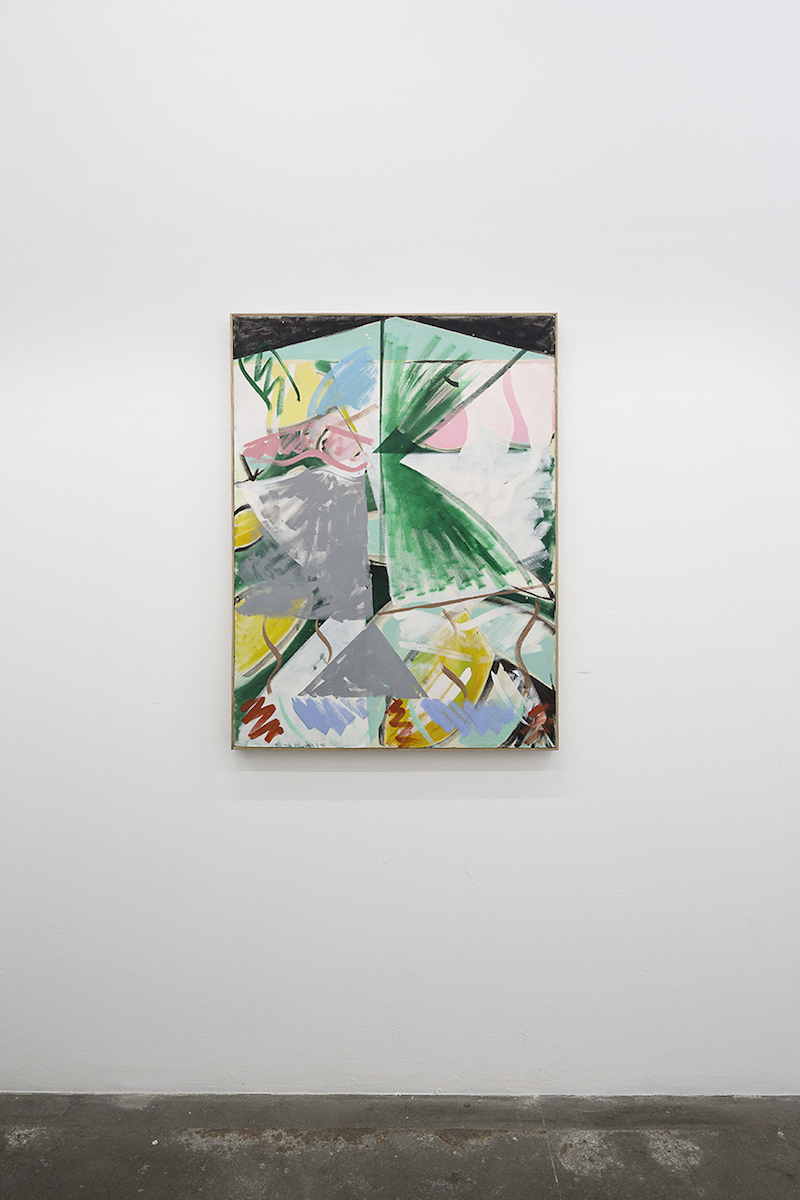
all works above © Jon Pilkington at V1 Gallery Copenhagen, 2016
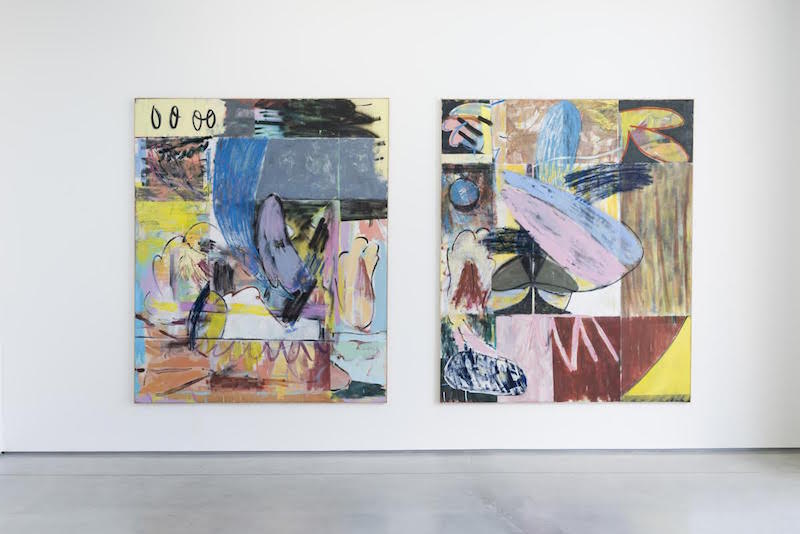
two paintings © Jon Pilkington at Rod Barton Gallery, London 2016
